Two-Stage Intelligent Model for Detecting Malicious DDoS Behavior
Abstract
:1. Introduction
- We generate a self-generated dataset that conforms to the actual traffic. The experiment simulates a large amount of benign traffic and different types of DDoS attack traffic in 5G scenarios.
- We propose a two-stage intelligent detection model. The model includes the similarity-based prior knowledge model and the CNN-based attention model.
- A similarity-based prior knowledge detection method for DDoS attacks is proposed. Through attack behavior analysis, we select five representative features. The probability distribution of the features is used to build a model based on the similarity with prior knowledge. The model can distinguish DDoS from benign traffic.
- A CNN-based attention DDoS attack detection method is proposed. The CNN-based attention detection model deeply learns 29 packet payload and packet header statistical features, selects the model’s best parameters, and indicates the specific types of DDoS attacks.
- We define a malicious detection capability metric. We apply the defined metric and common metrics to evaluate the proposed mechanism. By comparing with benchmark statistics and neural network algorithms, we show that the proposed approach performs well in terms of the detection rate, malicious detection capability, and response time.
2. Related Work
2.1. Dataset
2.2. Statistical Analysis Detection Method
2.3. Neural Network Detection Method
3. Detection Model
3.1. Two-Stage Detection Model
3.2. Statistical Detection Model
- (1)
- Collect flow and
- (2)
- Compute flow and similarity
- (3)
- Define whether abnormal traffic exists
| Algorithm 1 MFPK Precoder Algorithm. |
| Input: Flow X, Flow Y, M, L, K; |
| Output: True: abnormal, False: benign; |
| 1: for m = 0; m < M; m + + do |
| 2: for n = 0; n ≤ k; n + + do |
| 3: ; |
| 4: ; |
| 5: end for |
| 6: end for |
| 7: for l = 0; l < L; l + + do |
| 8: for n = 0; n ≤ k; n + + do |
| 9: ; |
| 10: ; |
| 11: end for |
| 12: end for |
| 13: |
| 14: then |
| 15: return True; |
| 16: end if |
| 17: return False; |
3.3. Neural Network Detection Model
| Algorithm 2 CNAT precoder Algorithm. |
| Input: The feature matrix F; the filter e; the feature number f; the maximum number of iterations R; the convolution filter weight w; the convolution filter bias b; the query matrix Wq; the key matrix Wk; the key matrix Wv; |
| Output: The traffic type; |
| 1: for epoches = 1 to E do |
| 2: initial w to be 0; b to be 0; |
| 3: for r = 1 to R do |
| 4: |
| 5: |
| 6: end for |
| 7: |
| 8: ; |
| 9: ; |
| 10: end for |
| 11: Add dense layer, classification layer |
| 12: return The traffic label; |
4. Methodology
4.1. Dataset
4.2. Evaluation Metric
5. Experimental Results
5.1. Distinguishing Attack Traffic from Benign Traffic
5.1.1. Similarity vs. Time Window
5.1.2. Detection Rate vs. Threshold Value
5.1.3. Comparison with Other Methods
5.2. Offline Train
5.2.1. Performance vs. Batch Size
5.2.2. Performance vs. Optimizer
5.2.3. Performance vs. Learning Rate
5.2.4. Comparison with Other Methods
5.3. Online Detection
5.3.1. Comparison with Other Methods
5.3.2. Online Detection Performance
6. Conclusions
- We will select representative features for each attack type, establish the neural network model suitable for this attack type, and improve the multi-classification performance by optimizing parameters.
- To verify the effectiveness of the generated self-generated dataset, we must further verify the effectiveness of the detection method on the existing benchmark dataset.
- We will introduce research on the interpretability of the deep learning model, and visualize the neural network training process. Furthermore, we will analyze the relationship between model weights and detection results.
- We will analyze the attention layer parameters and further adjust and optimize the model structure, which can enhance the model’s detection capability.
Author Contributions
Funding
Institutional Review Board Statement
Informed Consent Statement
Data Availability Statement
Conflicts of Interest
References
- Dutta, A.; Hammad, E. 5G Security Challenges and Opportunities: A System Approach. In Proceedings of the 2020 IEEE 3rd 5G World Forum (5GWF), Bangalore, India, 10–12 September 2020; pp. 109–114. [Google Scholar]
- NSFOCUS: 2019 DDoS Development Trend. Available online: http://blog.nsfocus.net/wp-content/uploads/2019/12/2019-DDoS.pdf (accessed on 16 October 2021).
- NSFOCUS: 2020 DDoS Development Trend. Available online: https://bestpractice.nsfocus.com.cn/html/2021/92_0121/148.html (accessed on 16 October 2021).
- CNCERT: 2020 Internet Network Security Monitoring Data Analysis Report. Available online: https://www.cert.org.cn/publish/main/upload/File/2020Report.pdf (accessed on 16 August 2021).
- Liu, Z.; Jin, H.; Hu, Y.; Bailey, M. Practical Proactive DDoS-Attack Mitigation via Endpoint-Driven In-Network Traffic Control. IEEE/ACM Trans. Netw. 2018, 26, 1948–1961. [Google Scholar] [CrossRef]
- GSMA: AI in Security. Available online: https://www.gsma.com/greater-china/resources/ai_in_security_cn/ (accessed on 10 January 2022).
- Behal, S.; Singh, J. Detection and Mitigation of DDoS attacks in SDN: A Comprehensive Review, Research Challenges and Future Directions. Comput. Sci. Rev. 2020, 37, 100279. [Google Scholar]
- Wang, W.; Shang, Y.; He, Y.; Li, Y.; Liu, J. Botmark: Automated botnet detection with hybrid analysis of flow-based and graph-based traffic behaviors. Inf. Sci. 2020, 511, 284–296. [Google Scholar] [CrossRef]
- Ghasabi, M.; Deypir, M. Using optimized statistical distances to confront distributed denial of service attacks in software defined networks. Intell. Data Anal. 2021, 25, 155–176. [Google Scholar] [CrossRef]
- Chen, M.H.; Zhu, Y.F.; Lu, B.; Zhai, Y.; Li, D. Classification of Application Type of Encrypted Traffic Based on Attention-CNN. Comput. Sci. 2021, 48, 325–332. [Google Scholar]
- Alzahrani, S.; Hong, L. Generation of DDoS Attack Dataset for Effective IDS Development and Evaluation. Int. J. Inf. Secur. 2018, 9, 225–241. [Google Scholar]
- Sharafaldin, I.; Lashkari, A.H.; Ghorbani, A.A. Toward generating a new intrusion detection dataset and intrusion traffic characterization. In Proceedings of the International Conference on Information Systems Security Privacy(ICISSP), Funchal, Portugal, 22–24 January 2018; pp. 1–8. [Google Scholar]
- Lima Filho, F.S.; Silveira, F.A.F.; Brito, A.D.M.; Solar, G.V.; Silveira, L.F. Smart detection: An online approach for DoS/DDoS attack detection using machine learning. Secur. Commun. Netw. 2019, 2019, 1574749. [Google Scholar] [CrossRef]
- Sreekesh, M. A two-tier network based intrusion detection system architecture using machine learning approach. In Proceedings of the 2016 International Conference on Electrical, Electronics, and Optimization Techniques (ICEEOT), Chenna, India, 3–5 March 2016; pp. 42–47. [Google Scholar]
- Abushwereb, M.; Mustafa, M.; Al-kasassbeh, M.; Qasaimeh, M. Attack based DoS attack detection using multiple classifier. arXiv 2020, arXiv:2001.05707. [Google Scholar]
- Koroniotis, N.; Moustafa, N.; Sitnikova, E.; Turnbull, B. Towards the development of realistic botnet dataset in the internet of things for network forensic analytics: Bot-IoT dataset. Future Gener. Comput. Syst. 2019, 100, 779–796. [Google Scholar] [CrossRef] [Green Version]
- Jian, S.J.; Lu, Z.G.; Mu, D.; Jiang, B.; Liu, B.X. Overview of Network Intrusion Detection Technology. J. Cyber Secur. 2020, 5, 96–122. [Google Scholar]
- Mishra, P.; Varadharajan, V.; Tupakula, U.; Pilli, E.S. A detailed investigation and analysis of using machine learning techniques for intrusion detection. IEEE Commun. Surv. Tutor. 2019, 21, 686–728. [Google Scholar] [CrossRef]
- Divekar, A.; Parekh, M.; Savla, V.; Mishra, R.; Shirole, M. Benchmarking datasets for anomaly-based network intrusion detection: Kddcup 99 alternatives. In Proceedings of the 2018 IEEE 3rd International Conference on Computing, Communication and Security (ICCCS), Kathmandu, Nepal, 25–27 October 2018; pp. 1–8. [Google Scholar]
- Kreutz, D.; Ramos, F.M.V.; Verssimo, P.E.; Rothenberg, C.E.; Azodolmolky, S.; Uhlig, S. Software-defined networking: A comprehensive survey. Proc. IEEE Inst. Electr. Electron. Eng. 2015, 103, 14–76. [Google Scholar] [CrossRef] [Green Version]
- CAIDA. The CAIDA Datasets. Available online: https://www.caida.org/about/annualreports/2017/ (accessed on 16 November 2021).
- The Shmoo Group. The Defcon Datasets. Available online: http://cctf.shmoo.com (accessed on 16 November 2021).
- ISCX. The ISCX Datasets. Available online: https://www.iscx.ca/datasets/ (accessed on 16 November 2021).
- Shiravi, A.; Shiravi, H.; Tavallaee, M.; Ghorbani, A. Toward developing a systematic approach to generate benchmark datasets for intrusion detection. Comput. Secur. 2012, 31, 357–374. [Google Scholar] [CrossRef]
- Kalkan, K.; Altay, L.; Gür, G.; Alagz, F. Jess: Joint entropy-based DDoS defense scheme in SDN. IEEE J. Sel. Areas Commun. 2018, 6, 2358–2372. [Google Scholar] [CrossRef]
- Sahoo, K.; Puthal, D.; Tiwary, M.; Rodrigues, J.J.; Sahoo, B.; Dash, R. An early detection of low rate DDoS attack to SDN based data center networks using information distance metrics. Future Gener. Comput. Syst. 2018, 89, 685–697. [Google Scholar] [CrossRef]
- Agrawal, N.; Tapaswi, S. Defense Mechanisms Against DDoS Attacks in a Cloud Computing Environment: State-of-the-Art and Research Challenges. IEEE Commun. Surv. Tut. 2019, 21, 3769–3795. [Google Scholar] [CrossRef]
- Shui, Y.; Guojun, W.; Wanlei, Z. Modeling Malicious Activities in Cyber Space. IEEE Netw. 2015, 29, 83–87. [Google Scholar]
- Shui, Y.; Song, G.; Ivan, S. Fool Me If You Can: Mimicking Attacks and Anti-attacks in Cyberspace. IEEE Trans. Comput. 2015, 64, 139–151. [Google Scholar]
- Yu, S.; Zhou, W.; Jia, W.; Guo, S.; Xiang, Y.; Tang, F. Discriminating DDoS Attacks from Flash Crowds Using Flow Correlation Coefficient. IEEE Trans. Parall. Distr. 2012, 23, 1073–1080. [Google Scholar] [CrossRef]
- Callegari, C.; Giordano, S.; Pagano, M. Histogram cloning and CuSum: An experimental comparison between different approaches to anomaly detection. In Proceedings of the International Symposium on Performance Evaluation of Computer and Telecommunication Systems (SPECTS), Chicago, IL, USA, 26–29 July 2015; pp. 1–7. [Google Scholar]
- Kailath, T. The Divergence and Bhattacharyya Distance Measures in Signal Selection. IEEE Trans. Commun. Technol. 1967, 15, 52–60. [Google Scholar] [CrossRef]
- Makuvaza, A.; Jat, D.; Gamundani, A. Deep neural network (DNN) solution for real-time detection of distributed denial of service (DDoS) attacks in software defined networks (SDNs). SN Comput. Sci. 2021, 2, 107. [Google Scholar] [CrossRef]
- Samani, E.B.B.; Jazi, H.H.; Stakhanova, N.; Ghorbani, A.A. Towards effective feature selection in machine learning-based botnet detection approaches. In Proceedings of the IEEE Conference on Communications and Network Security (CNS), San Francisco, CA, USA, 29–31 October 2014; pp. 247–255. [Google Scholar]
- Harrou, F.; Nounou, M.N.; Nounou, H.N.; Madakyaru, M. PLS-based EWMA fault detection strategy for process monitoring. J. Loss Prev. Proc. 2015, 36, 108–119. [Google Scholar] [CrossRef]
- McDermott, C.D.; Majdani, F.; Petrovski, A.V. Botnet detection in the internet of things using deep learning approaches. In Proceedings of the 2018 International Joint Conference on Neural Networks (IJCNN), Rio de Janeiro, Brazil, 8–13 July 2018; pp. 1–8. [Google Scholar]
- Guoyi, M.; Xin, Z.A. Classification Method of Android Traffic based on Convolutional Neural Network. Commun. Technol. 2020, 53, 432–437. [Google Scholar]
- Wang, W.; Zhu, M.; Zeng, X.; Ye, X.; Sheng, Y. Malware traffic classification using convolutional neural network for representation learning. In Proceedings of the 2017 International Conference on Information Networking (ICOIN), Da Nang, Vietnam, 11–13 January 2017; pp. 712–717. [Google Scholar]
- Wang, W.; Zhu, M.; Wang, J.; Zeng, X.; Yang, Z. End-to-end encrypted traffic classification with one-dimensional convolution neural networks. In Proceedings of the 2017 IEEE International Conference on Intelligence and Security Informatics (ISI), Beijing, China, 22–24 June 2017; pp. 43–48. [Google Scholar]
- Jiang, J.; Zhang, H.; Dai, C.; Zhao, Q.; Feng, H.; Ji, Z.; Ganchev, I. Enhancements of attention-based bidirectional lstm for hybrid automatic text summarization. IEEE Access 2021, 9, 123660–123671. [Google Scholar] [CrossRef]
- Malik, J.; Akhunzada, A.; Bibi, I.; Imran, M.; Musaddiq, A.; Kim, S.W. Hybrid deep learning: An efficient reconnaissance and surveillance detection mechanism in sdn. IEEE Access 2020, 8, 134695–134706. [Google Scholar] [CrossRef]
- Fu, J.; Liu, J.; Tian, H.; Li, Y.; Bao, Y.; Fang, Z.; Lu, H. Dual attention network for scene segmentation. arXiv 2019, arXiv:1809.02983. [Google Scholar]
- Wenqian, J. Research on Cooperative DDoS Attack Detection Mechanism in Programmable Network. Master’s Thesis, Beijing Jiaotong University, Beijing, China, 18 May 2020. [Google Scholar]
- Wang, C.; Miu, T.T.N.; Luo, X.; Wang, J. Skyshield: A sketch-based defense system against application layer DDoS attacks. IEEE Trans. Inf. Forens. Secur. 2018, 13, 559–573. [Google Scholar] [CrossRef]
- Mogyorsi, F.; Pai, A.; Cziva, R.; Revisnyei, P.; Kenesi, Z.; Tapolcai, J. Adaptive protection of scientific backbone networks using machine learning. IEEE Trans. Netw. Serv. 2021, 18, 1064–1076. [Google Scholar] [CrossRef]
- Tianqi, Y.; Weilin, W.; Ying, L.; Huachun, Z. Multi-class DRDoS Attack Detection Method Based on Feature Selection. ReBICTE 2021, 7, 1–15. [Google Scholar]
- Navarro-Ortiz, J.; Romero-Diaz, P.; Sendra, S.; Ameigeiras, P.; Ramos-Munoz, J.J.; Lopez-Soler, J.M. A Survey on 5G Usage Scenarios and Traffic Models. IEEE Commun. Surv. Tut. 2020, 22, 905–929. [Google Scholar] [CrossRef]
- Latah, M.; Toker, L. Towards an efficient anomaly-based intrusion detection for software-defined networks. arXiv 2018, arXiv:1803.06762. [Google Scholar] [CrossRef] [Green Version]
- Chang, S.; Qiu, X.; Gao, Z.; Qi, F.; Liu, K. A flow-based anomaly detection method using entropy and multiple traffic features. In Proceedings of the 2010 3rd IEEE International Conference on Broadband Network and Multimedia Technology (IC-BNMT), Beijing, China, 26–28 October 2010; pp. 223–227. [Google Scholar]
- Bereziski, P.; Jasiul, B.; Szpyrka, M. An entropy-based network anomaly detection method. Entropy 2015, 17, 2367–2408. [Google Scholar] [CrossRef]
- Carvalho, L.F.; Abro, T.; de Souza Mendes, L.; Proena, M.L. An ecosystem for anomaly detection and mitigation in software-defined networking. Expert Syst. Appl. 2018, 104, 121–133. [Google Scholar] [CrossRef]
- CICFlowMeter: A Network Traffic Flow Analyzer. Available online: https://github.com/CanadianInstituteForCybersecurity/CICFlowMeter (accessed on 20 December 2020).
- Amaizu, G.; Nwakanma, C.; Bhardwaj, S.; Lee, J.; Kim, D. Composite and efficient DDoS attack detection framework for B5G networks. Comput. Netw. 2021, 188, 107871. [Google Scholar] [CrossRef]
- He, H.; Zhang, H.L.; Wei, Z.; Fang, B.X.; Hu, M.Z.; Chen, L. A DDoS intrusion detection method based on likeness. J. Commun. 2004, 25, 176–184. [Google Scholar]
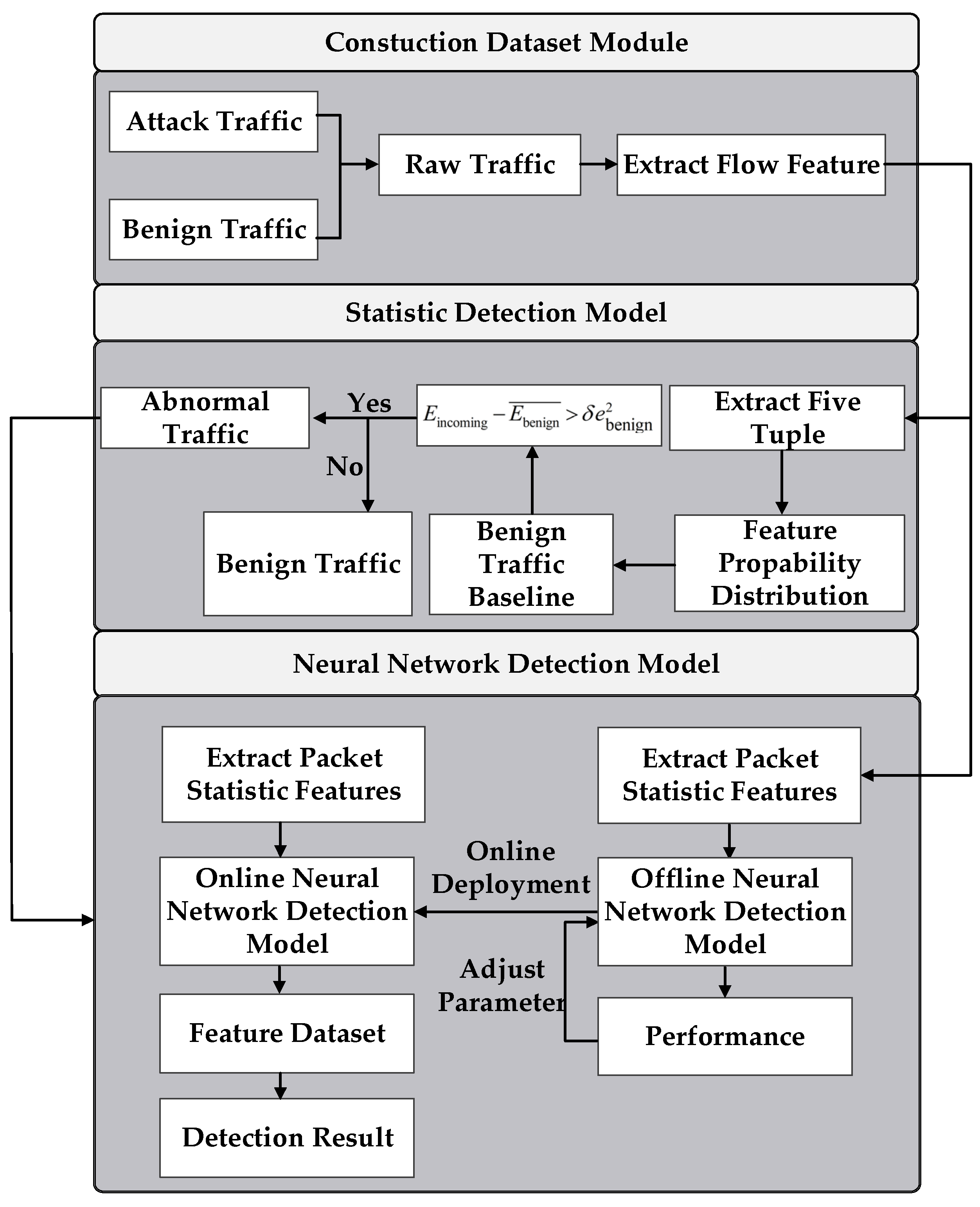

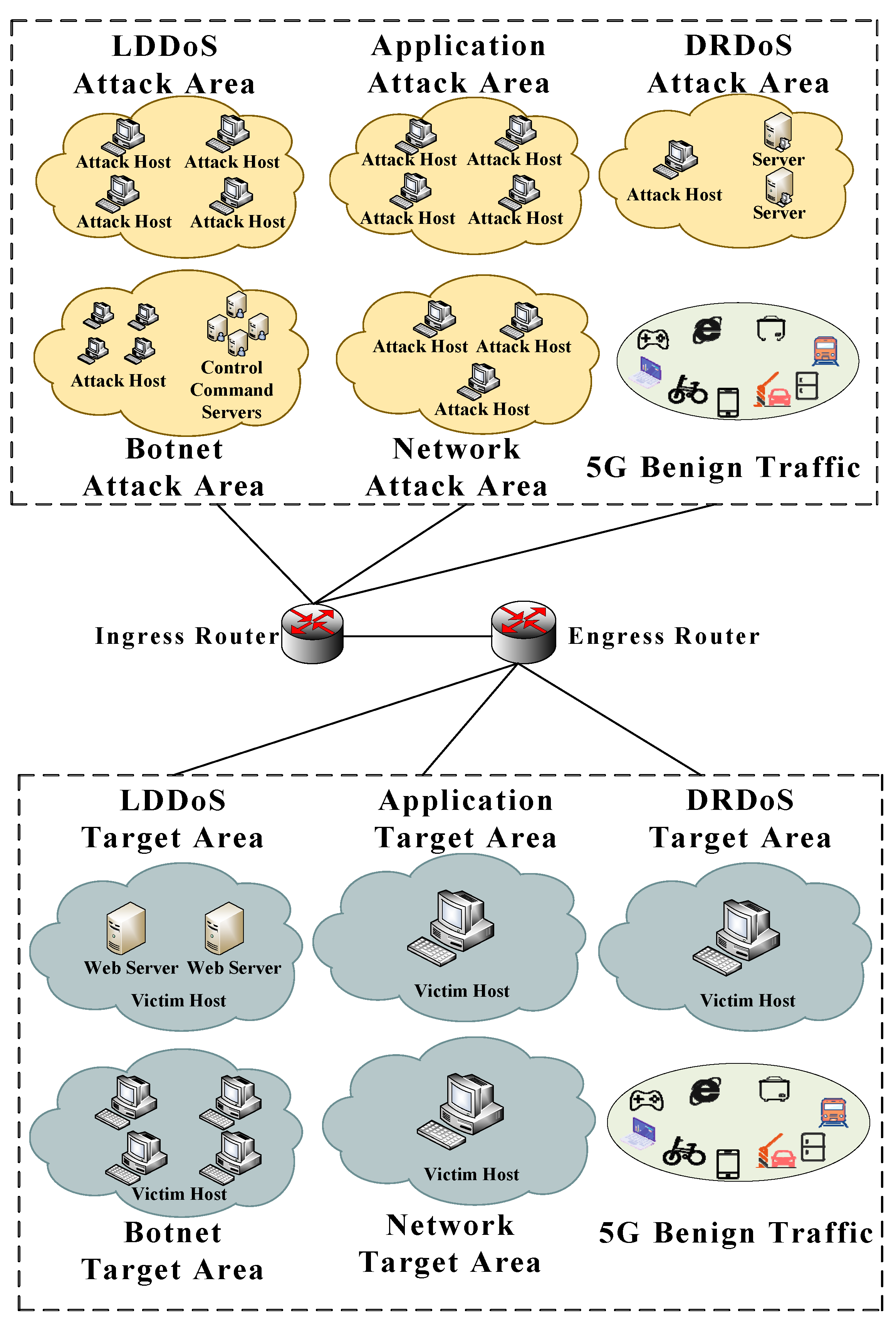
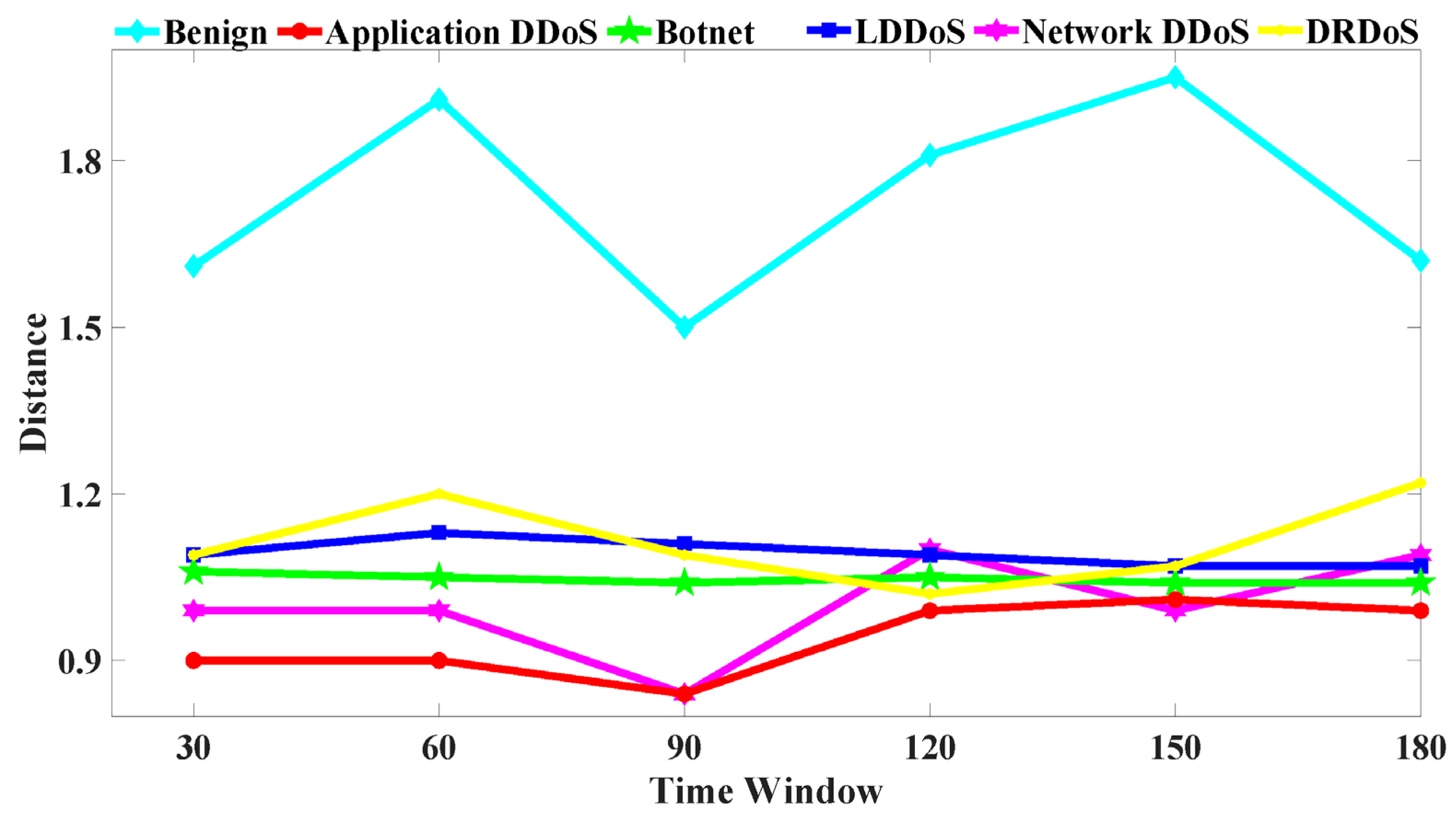

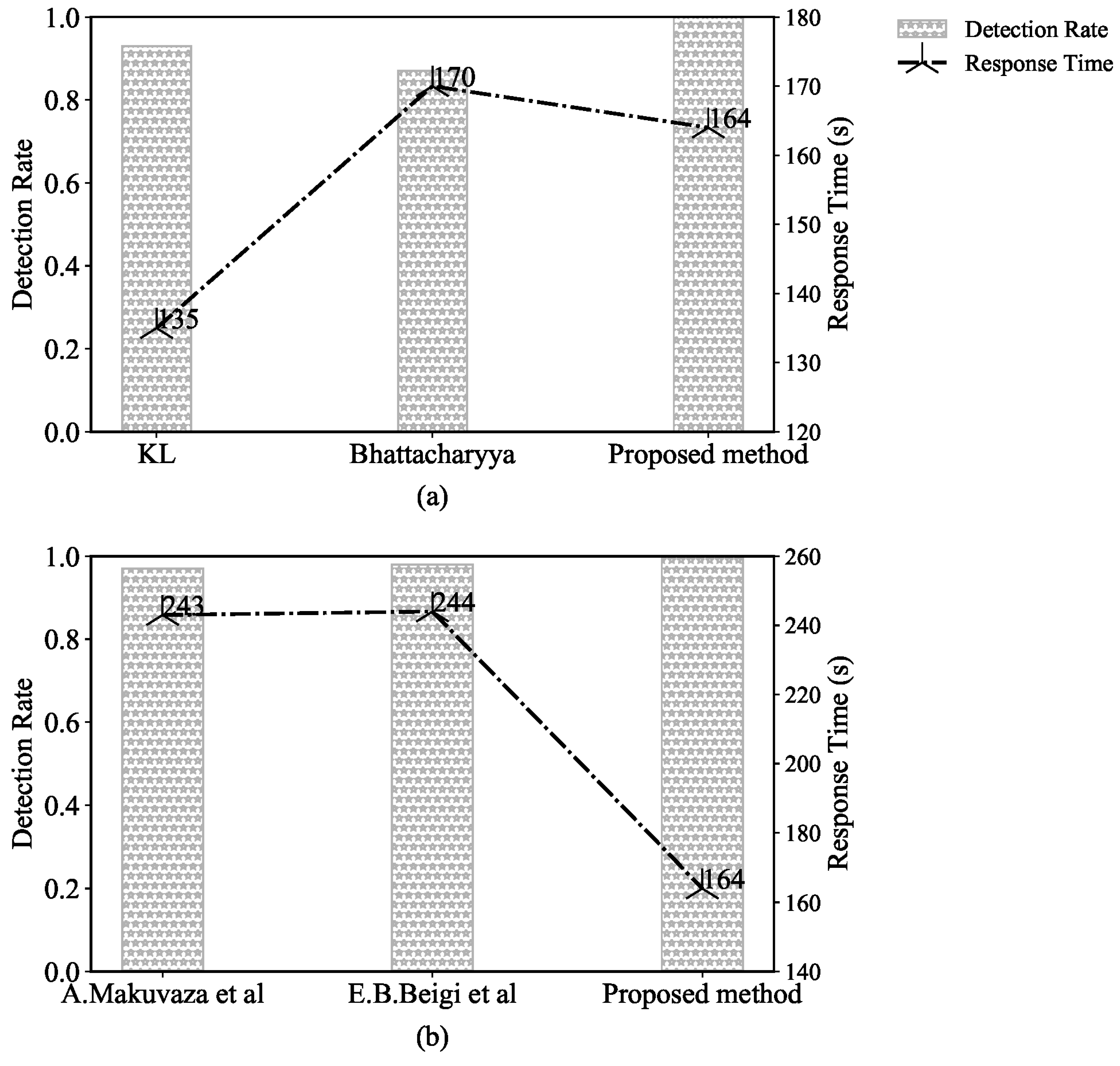
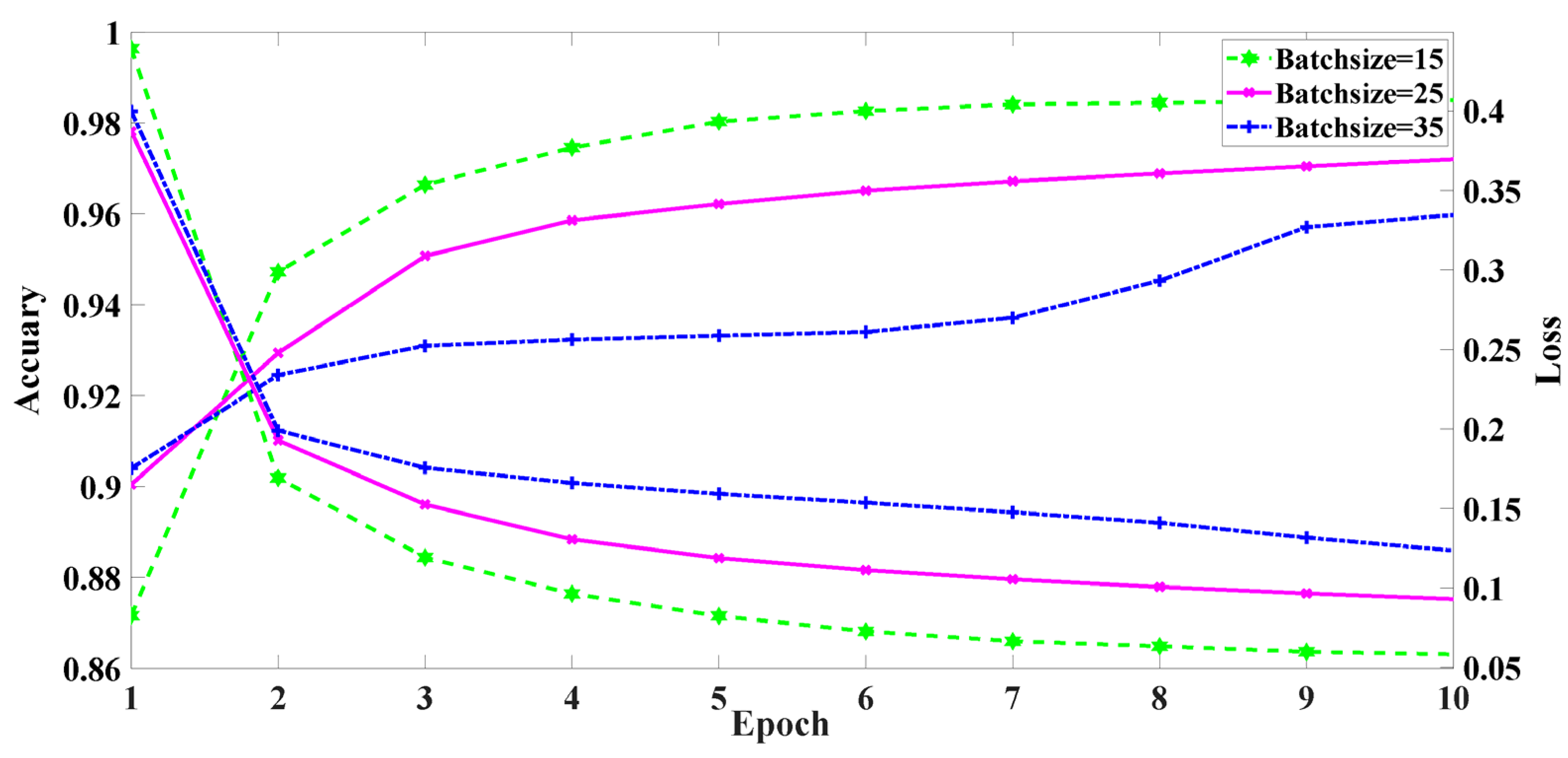
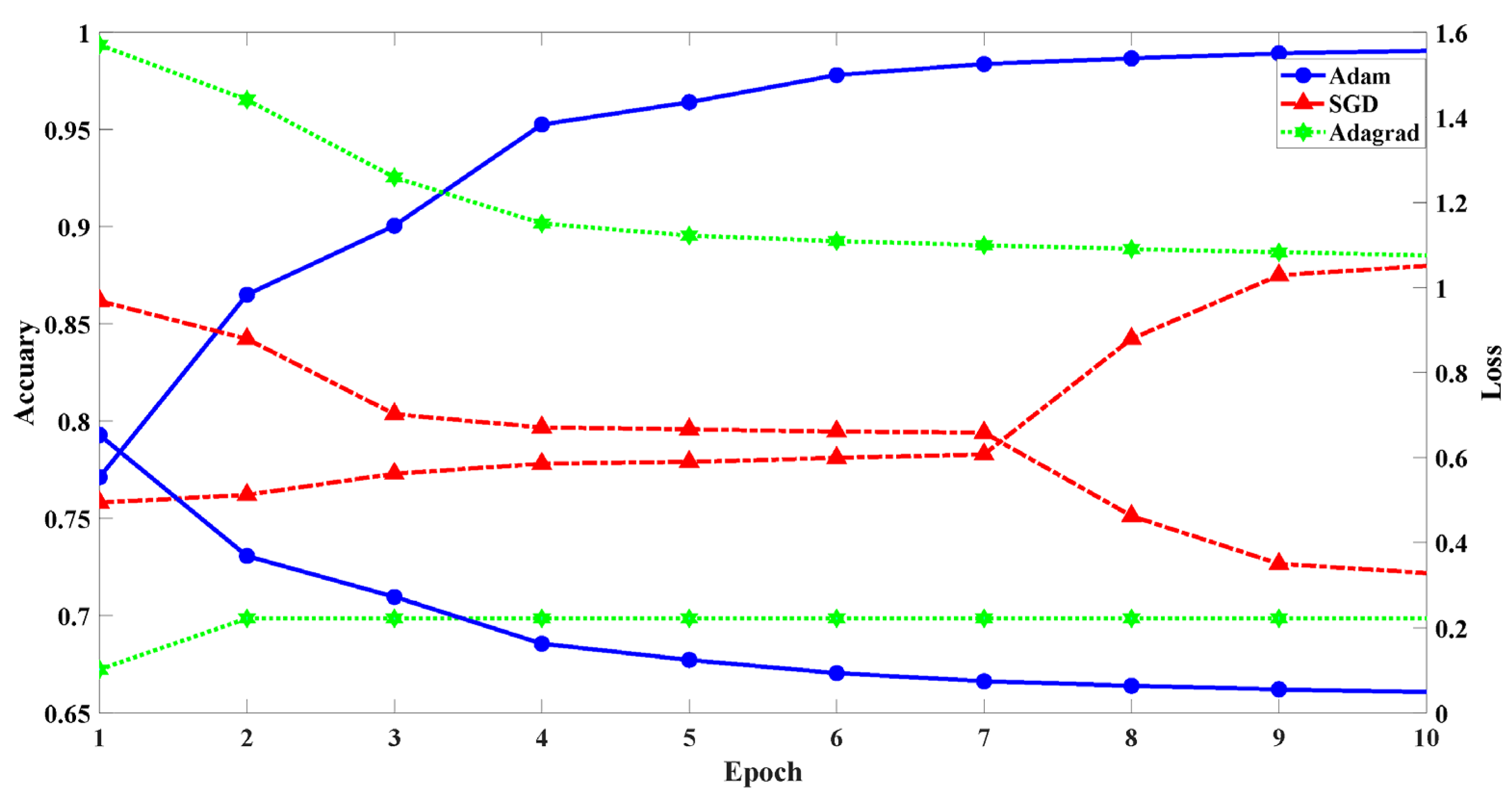

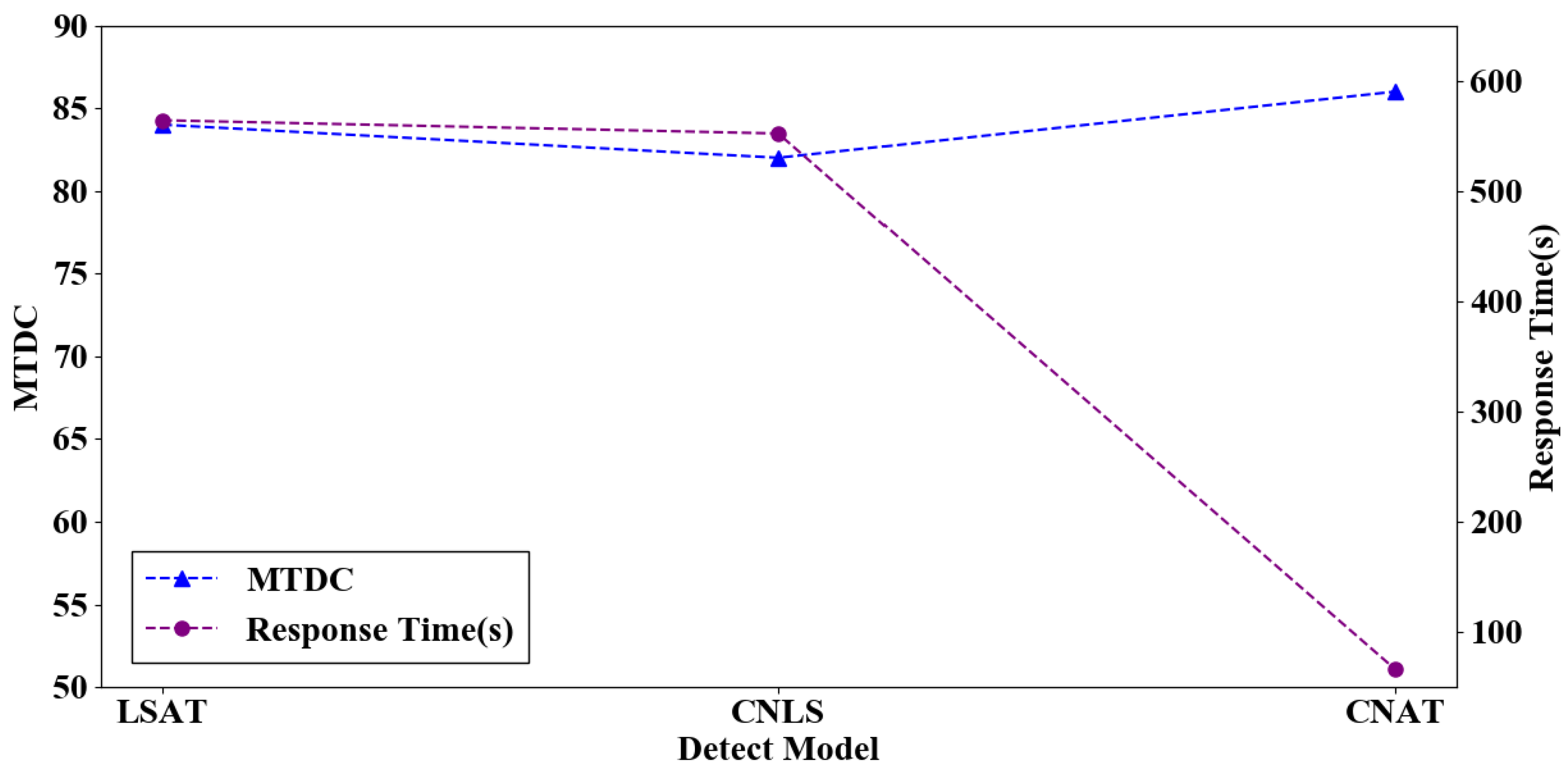
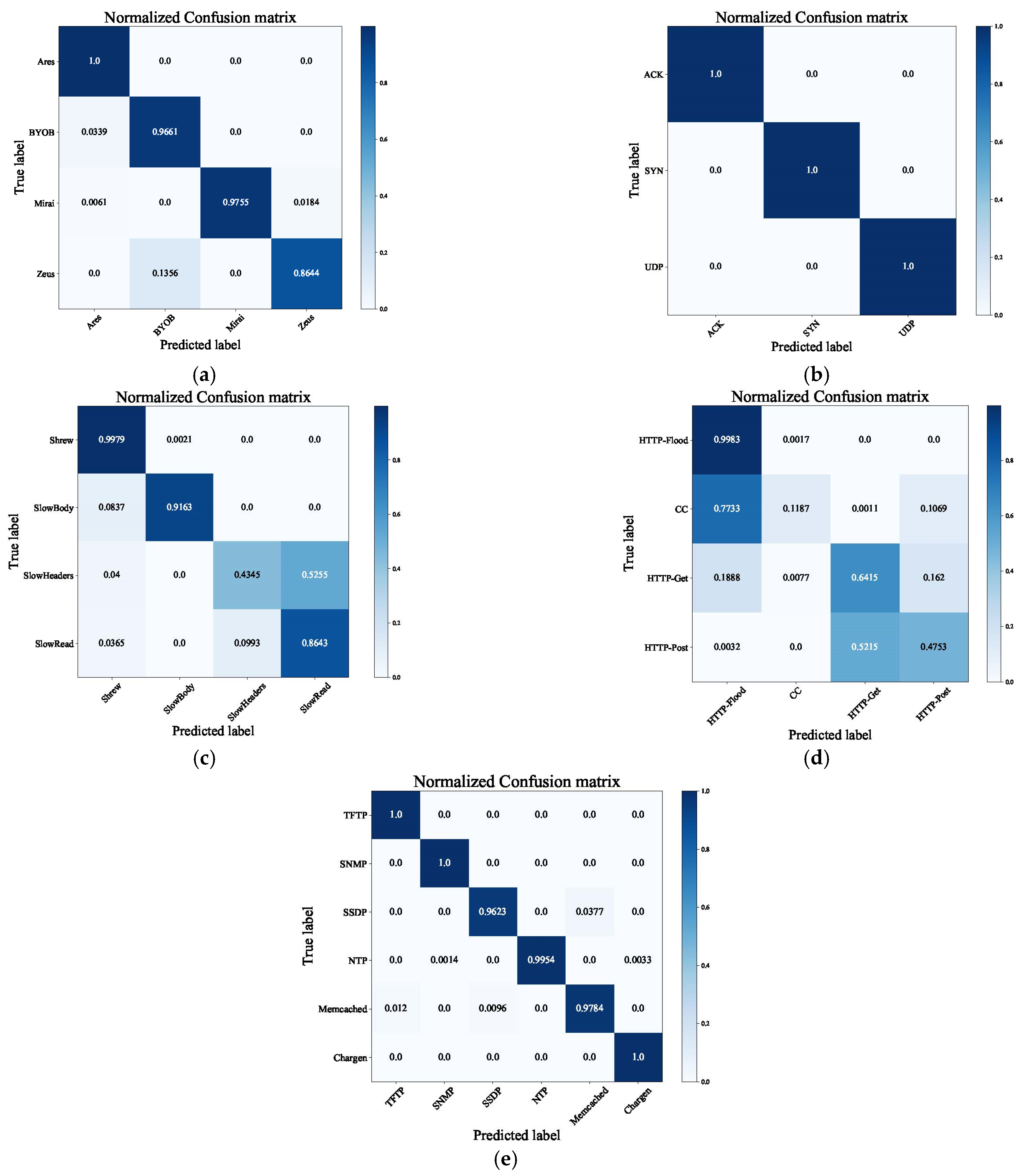
| Configure | Type |
|---|---|
| System | Ubuntu 18.04 live server |
| Hard Disk | 32 G |
| RAM | 16 GB |
| Collection Time | SrcIP | DstIP | Label |
|---|---|---|---|
| 11 May 2021, 20.00–23.50 13 May 2021, 15:00 19 May 2021, 12:00 | 10.1.0.20–10.1.0.30 | 10.1.1.1 | Benign |
| 10.1.0.1 | 10.1.1.1 | Ares | |
| 10.1.0.2 | 10.1.1.2 | BYOB | |
| 10.1.0.4 | 10.1.1.4 | Mirai | |
| 10.1.0.7 | 10.1.1.99 | Zeus | |
| 22 May 2021, 15:31–15:56 | 12.1.0.1 | 12.1.1.1 | CC |
| 12.1.0.2 | 12.1.1.1 | HTTP-Flood | |
| 12.1.0.3 | 12.1.1.1 | HTTP-Post | |
| 12.1.0.4 | 12.1.1.1 | HTTP-Get | |
| 12.1.1.20–12.1.1.30 | 12.1.0.3 | Benign | |
| 22 May 2021, 20:14–20.25 | 12.1.0.4 | 12.1.0.3 | Memcached, Chargen, NTP, SSDP, SNMP, TFTP |
| 12.1.1.20–12.1.1.30 | 12.1.0.3 | Benign | |
| 23 May 2021, 11:08–11:11 | 13.1.0.3 | 13.1.1.1 | SYN |
| 13.1.0.20–13.1.0.30 | 13.1.1.1 | Benign | |
| 23 May 2021, 11:13–11:16 | 13.1.0.2 | 13.1.1.1 | ACK |
| 13.1.0.20–13.1.0.30 | 13.1.1.1 | Benign | |
| 23 May 2021, 11:18–11:21 | 13.1.0.1 | 13.1.1.1 | UDP |
| 13.1.0.20–13.1.0.30 | 13.1.1.1 | Benign | |
| 23 May 2021, 15:35–16:15 | 11.1.0.1 | 11.1.1.1 | Slow Headers |
| 11.1.0.2 | 11.1.1.1 | Slow Body | |
| 11.1.0.3 | 11.1.1.1 | Slow Read | |
| 11.1.0.4 | 11.1.1.1 | Shrew | |
| 11.1.0.20–11.1.0.30 | 11.1.1.1 | Benign |
| Type | Proportion | Number | |
|---|---|---|---|
| Benign | Benign | 0.3127 | 880,693 |
| Network DDoS | ACK | 0.0465 | 131,072 |
| UDP | 0.0464 | 130,844 | |
| SYN | 0.0448 | 126,415 | |
| LDDoS | SlowBody | 0.0348 | 98,148 |
| Shrew | 0.0157 | 44,280 | |
| SlowHeaders | 0.0342 | 96,542 | |
| SlowRead | 0.023 | 64,997 | |
| Botnet | Ares | 0.252 | 709,748 |
| BYOB | 0.001 | 2926 | |
| Mirai | 0.0007 | 2251 | |
| Zeus | 0.0001 | 327 | |
| DRDoS | TFTP | 0.0141 | 39,977 |
| Memcached | 0.0137 | 38,586 | |
| SSDP | 0.0044 | 12,513 | |
| NTP | 0.0033 | 9319 | |
| Chargen | 0.0004 | 1269 | |
| SNMP | 0.0002 | 582 | |
| Application DDoS | CC | 0.09 | 253,525 |
| HTTP-Get | 0.0225 | 3435 | |
| HTTP-Flood | 0.0202 | 56,886 | |
| HTTP-Post | 0.0183 | 51,556 | |
| No. | Feature Name | No. | Feature Name |
|---|---|---|---|
| 1 | Total Fwd Packet | 16 | Subflow Bwd Bytes |
| 2 | Total Length of Fwd Packet | 17 | Total Bwd packets |
| 3 | Fwd Packet Length Max | 18 | Total Length of Bwd Packet |
| 4 | Fwd Packet Length Min | 19 | Bwd Packet Length Max |
| 5 | Fwd Header Length | 20 | Bwd Packet Length Min |
| 6 | Fwd Packet Length Mean | 21 | Bwd Header Length |
| 7 | Fwd Packet Length Std | 22 | Bwd Packet Length Mean |
| 8 | Fwd Segment Size Avg | 23 | Bwd Packet Length Std |
| 9 | Packet Length Min | 24 | Bwd Segment Size Avg |
| 10 | Packet Length Max | 25 | Packet Length Variance |
| 11 | Packet Length Mean | 26 | Average Packet Size |
| 12 | Packet Length Std | 27 | Fwd Segment Size Avg |
| 13 | Subflow Fwd Packets | 28 | Bwd Segment Size Avg |
| 14 | Fwd Seg Size Min | 29 | Subflow Bwd Packets |
| 15 | Subflow Fwd Bytes |
| Type | Number of Abnormal Traffic Events |
|---|---|
| Training Set | 1,607,313 |
| Testing Set | 267,885 |
| Type | LSTM + Attention(LSAT) | CNN + LSTM(CNLS) | CNAT | ||||||||||
|---|---|---|---|---|---|---|---|---|---|---|---|---|---|
| Pre | Rec | MTDC | Response Time (min) | Pre | Rec | MTDC | Response Time (min) | Pre | Rec | MTDC | Response Time (min) | ||
| Botnet | Ares | 0.99 | 0.99 | 81 | 141 | 0.99 | 0.99 | 69 | 166 | 0.96 | 0.99 | 97 | 20 |
| BYOB | 0.91 | 0.68 | 0.85 | 0.7 | 0.81 | 0.97 | |||||||
| Zeus | 0.99 | 0.58 | 0.44 | 0.09 | 0.91 | 0.93 | |||||||
| Mirai | 0.99 | 0.99 | 0.99 | 0.99 | 0.91 | 0.99 | |||||||
| Net- work | SYN | 0.99 | 0.99 | 99 | 140 | 0.99 | 0.99 | 99 | 156 | 0.99 | 0.99 | 99 | 22 |
| ACK | 0.99 | 0.99 | 0.99 | 0.99 | 0.99 | 0.99 | |||||||
| UDP | 0.99 | 0.99 | 0.99 | 0.99 | 0.99 | 0.99 | |||||||
| LD- DoS | Slow Body | 0.99 | 0.98 | 75 | 135 | 0.99 | 0.93 | 75 | 142 | 0.95 | 0.91 | 71 | 21 |
| Slow Headers | 0.76 | 0.6 | 0.77 | 0.65 | 0.8 | 0.43 | |||||||
| Slow Read | 0.57 | 0.78 | 0.58 | 0.78 | 0.52 | 0.86 | |||||||
| Shrew | 0.99 | 0.66 | 0.99 | 0.67 | 0.99 | 0.66 | |||||||
| Appli- cation | CC | 0.56 | 0.49 | 58 | 151 | 0.68 | 0.46 | 64 | 161 | 0.62 | 0.04 | 46 | 23 |
| HTTP Flood | 0.8 | 0.97 | 0.81 | 0.97 | 0.92 | 0.99 | |||||||
| HTTP Get | 0.79 | 0.31 | 0.75 | 0.46 | 0.43 | 0.48 | |||||||
| HTTP Post | 0.83 | 0.57 | 0.85 | 0.67 | 0.67 | 0.35 | |||||||
| DR- DoS | NTP | 0.96 | 0.99 | 99 | 113 | 0.94 | 0.99 | 98 | 171 | 0.99 | 0.99 | 97 | 18 |
| SNMP | 0.95 | 0.99 | 0.98 | 0.98 | 0.93 | 0.99 | |||||||
| SSDP | 0.97 | 0.99 | 0.95 | 0.99 | 0.96 | 0.96 | |||||||
| Chargen | 0.89 | 0.99 | 0.91 | 0.99 | 0.88 | 0.99 | |||||||
| Memcached | 0.99 | 0.99 | 0.99 | 0.99 | 0.93 | 0.99 | |||||||
| TFTP | 0.97 | 0.99 | 0.95 | 0.99 | 0.95 | 0.94 | |||||||
Publisher’s Note: MDPI stays neutral with regard to jurisdictional claims in published maps and institutional affiliations. |
© 2022 by the authors. Licensee MDPI, Basel, Switzerland. This article is an open access article distributed under the terms and conditions of the Creative Commons Attribution (CC BY) license (https://creativecommons.org/licenses/by/4.0/).
Share and Cite
Li, M.; Zhou, H.; Qin, Y. Two-Stage Intelligent Model for Detecting Malicious DDoS Behavior. Sensors 2022, 22, 2532. https://doi.org/10.3390/s22072532
Li M, Zhou H, Qin Y. Two-Stage Intelligent Model for Detecting Malicious DDoS Behavior. Sensors. 2022; 22(7):2532. https://doi.org/10.3390/s22072532
Chicago/Turabian StyleLi, Man, Huachun Zhou, and Yajuan Qin. 2022. "Two-Stage Intelligent Model for Detecting Malicious DDoS Behavior" Sensors 22, no. 7: 2532. https://doi.org/10.3390/s22072532
APA StyleLi, M., Zhou, H., & Qin, Y. (2022). Two-Stage Intelligent Model for Detecting Malicious DDoS Behavior. Sensors, 22(7), 2532. https://doi.org/10.3390/s22072532






